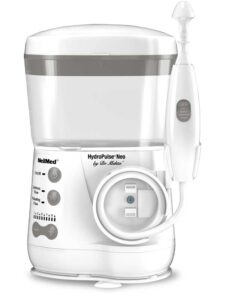Safe Nasal/Sinus Irrigation
Two Louisiana residents died after using Neti Pot irrigation! Is nasal irrigation safe? Nasal irrigation can be safe, if patient understands the principles of irrigation.
Dr Murray Grossan, board certified specialist in Ear Nose and Throat has published articles and books* about safe nasal irrigation since the ‘70’s. These are the principles of safe sinus irrigation:
1. Use uncontaminated water. Avoid Louisiana pond water.
2. Irrigate with a gentle steady pressure.
3. Prevent re-infection from devices that allow pull back nasal mucus into the device. (flowback)
4. The correct head position is important to avoid spreading bacteria to unaffected areas. The head should be bent forward looking straight down.
5. Do not irrigate to excess. The nose contains healing products .
6. Assist your body’s natural healing with humming, pulse wave irrigation, yogurt, probiotics, good sleep, etc. Reduce the need for irrigation.
7. Follow directions for sterility and biofilm.
Avoid Contaminated water
It is a mistake to think that distilled water solves all problems from sinus irrigation. For example, sniffing salt water from cupped hands: unless the hands have been sterilized thoroughly, the hands contain significant and often harmful bacteria and viruses.
Pressure should be gentle:
Just as blowing your nose too hard can push bacteria into otherwise normal tissues or into the ears, so can irrigating with too much or uneven pressure move bacteria from an unhealthy sinus area to a healthy one, or into the ears. For example, in using the Hydro Pulse® Nasal/Sinus Irrigator the stream is regulated so that it is a steady even one inch high. This is a pressure known to be safe. With the pot, the pressure may be high at first. With the squeeze bottle it takes practice to get it just right.
You don’t want use a high pressure to force bacteria out of the sinuses. You do want to restore normal nasal cilia function so that the cilia move the bacteria out out of the sinuses.
Irrigate Correctly
The head should be bent forward so you can see the sink drain clearly and held midline, not bent to the side. If you lay your head to the side, this allows the solution to accumulate where the Eustachian tube opening to the ear iis located.
The temperature of the water should be a warm comfortable one.
When you irrigate it must be a saline solution. Irrigating with plain distilled water is uncomfortable and not healthy for the nose.
Infection from the irrigation device:
Flowback: Irrigation devices regularly become contaminated. This is because as the squeeze bottle expands, it sucks nasal contents into the bottle. Or the contents flow back into the spigot of the pots.
Dr Talal Nsouli •showed that about 60% of patients had an increase in nasal/sinus infections when they continued use of pots and bottles over several months time, caused by reinfection and removal of natural healing products such as immunoglobulins, lysozyme and lactoferins.
* Long-Term Use of Nasal Saline Irrigation: Harmful or Helpful?” was presented at the American College of Allergy on Nov 7, 2009.
JM Lee reported that , despite careful instruction of his patients, 50% showed contamination from the irrigation bottles after one week of use. The contamination was due to Pseudomonas aeruginosa. JM Lee. Am J Rhinol Allergy. 2010 May-Jun:24(3) Assessing the risk of irrigation bottle and fluid contamination…
In one study* patients with chronic rhinosinusitis were given a fresh bottle every two weeks to irrigate with. After two weeks of use, 97% of the bottles showed contamination and 51% of these showed staph aureus. Four out of six bottles showed biofilm in the bottles after only two weeks of use! *M Keen The Clinical significance of nasal irrigation bottle contamination. Laryngoscope,2010 Oct:120 (10)
Avoid unnecessary irrigation:
Just because pulse wave irrigation feels pleasant and refreshing, once the nasal cilia and the nose are back to normal, you don’t need to be more normal. The nose produces natural products that defend the body, including immunoglobulins, lysozyme and lactoferins and you need to have these for your health.
Assist your body’s healing:
Irrigation is not the only method to clear a sinus condition. Humming at a low pitch–OMMMM helps restore nasal cilia. Yogurt and Probiotics assist your immune system. Good sleep is important. When you use pulse wave irrigation, try to visualize that the gentle waves are rocking the cilia back and forth; this can speed the healing.
Good sterility.
Biofilm is where the bacteria have built up covers that protect them from antibiotics and normal therapy. They are like a scum, hard to remove. You may need to scrub with soap and water. Remember that you need to clean the pot BEFORE you irrigate, once you have used it previously. After one person has used it, it is best not to have another use that same one.
This does not apply to the Hydro Pulse® Nasal/Sinus Irrigator. It is designed for multiple users and multiple tips are provided.
How to sterilize? For the Hydro Pulse a bleach mix of 1:10 is recommended once a week. Fill the reservoir, insert the tip into the bleach mix and run it back into the basin. Let stand for 10 minutes, then rinse out thoroughly. Or, the basin can be filled with hydrogen peroxide 3%, place the nasal tip into the reservoir, run through and let stand for four hours. For other devices a similar routine works well.
Remember that nasal irrigation is NOT a hose that forces bacteria out of the nose. The goal is to restore the nasal cilia so that they do the job properly and naturally.



You must be logged in to post a comment.